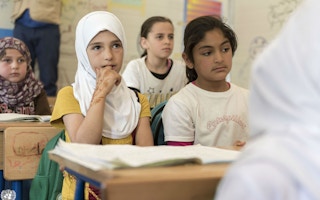As global business and political leaders gather in Davos for the World Economic Forum’s annual meeting, they should ask themselves one big question: Will the world achieve the ambitious Sustainable Development Goals for 2030?
Or will the SDGs — with their targets for eradicating extreme poverty, ending preventable child deaths, expanding educational opportunity, and averting a climate disaster — join the long list of enthusiastically endorsed global pledges that go unfulfilled?
Those suffering from early new-decade SDG blues might take comfort from Harvard psychologist Steven Pinker. Building on the core theme of his influential book Enlightenment Now, and citing a familiar barrage of statistics on human progress, Pinker has offered an upbeat assessment: “Progress toward [the SDGs] is continuing,” he wrote. “It is unlikely to do a sudden U-turn.”
He is right, up to a point. Since 2000, there have been extraordinary improvements in human-development indicators. Poverty has been decreasing at historically unprecedented rates: the share of the world’s population living on less than $1.90 per day has fallen from 28 per cent to 10 per cent. The risk of children born in Africa dying before their fifth birthday has been halved, saving millions of young lives. Out-of-school numbers have fallen dramatically, and gender gaps in school attendance are shrinking.
Over 1.6 billion people have gained access to clean drinking water. Such achievements refute the pessimism that often pervades public debates about aid and international development.
So far so good. But here’s the catch: if progress over the next ten years mirrors that of the last decade, the world will fall catastrophically short of the 2030 targets.
Consider child survival. On current trends, there will still be over four million child deaths worldwide in 2030. The vast majority of these fatalities could be prevented through improved nutrition and basic health-care interventions. But progress toward eradicating malnutrition, which is implicated in half of child deaths worldwide, has been glacial, and millions of children are living beyond the reach of health systems.
Pneumonia, which is now the single biggest infectious killer of children, claiming a life every 40 seconds, can be prevented with vaccination and treated with basic antibiotics (costing less than $0.50) and oxygen. Yet, the fatality count is falling far too slowly.
There is a similar yawning gap between current trends and the 2030 targets for education. Although governments have committed to ensuring universal secondary schooling and improved learning, progress toward universal primary education has stalled.
“
If progress over the next ten years mirrors that of the last decade, the world will fall catastrophically short of the 2030 targets.
In an increasingly knowledge-based global economy, a combination of restricted access to education and abysmal learning outcomes will leave one billion children lacking the skills they need to flourish, and that their countries need to drive dynamic and inclusive growth.
Likewise, for all the success in combating poverty, past performance is no guide to future outcomes. The pace of progress has slowed, and the goal of eliminating extreme poverty by 2030 is drifting out of reach. That is largely because of slow growth, inequality, and demographic trends in Sub-Saharan Africa, where the number of people living in poverty is increasing.
Research by the Overseas Development Institute suggests that more than 300 million African children will be living below the $1.90-per-day threshold in 2030 — and these children will account for more than one-half of the world’s poor.
The specter of climate change threatens the SDGs just as surely as it does the receding snow line around Davos. If the 2015 Paris climate agreement held out the promise of concerted international action to limit global warming, last month’s COP25 climate-change conference in Madrid was a case study in inertia.
The emissions gap between current policies and those needed to keep global warming below 1.5º Celsius is widening, and the world’s poorest and most vulnerable people are bearing the brunt of the consequences, as the recent droughts in Zambia and the Horn of Africa illustrate.
This is the decade of no return for the climate emergency. Failure to price carbon out of the world’s economies, safeguard carbon sinks, and — critically — protect the world’s poor against the effects of global warming that are now irreversible will first slow, and then stall and reverse, gains in poverty reduction, nutrition, and health.
We cannot allow these challenges’ daunting scale to foster passive acceptance of the inevitability of the SDGs’ failure. Nor should we tolerate the paralysing complacency that now pervades gatherings like Davos, World Bank-International Monetary Fund meetings, and United Nations summits. There is an alternative.
Nothing would do more to bring the SDG targets within reach than a concerted drive to narrow the social disparities currently acting as a brake on progress.
To take one example, closing the gap in national death rates between children from the richest and poorest 20 per cent of the world’s population would save more than two million lives between now and 2030. That will require further investment in universal health coverage, more equitable public spending and service provision, and greater emphasis on the diseases that kill the poorest children.
Greater equity is the rocket fuel for achieving the SDGs. Instead of issuing vague pronouncements about “leaving no one behind,” governments should report on how quickly they are reducing inequalities.
International action has a critical role to play. Later this month, Save the Children, UNICEF, and other partners will convene a global forum on pneumonia aimed at expanding access to life-saving interventions. Toward the end of this year, the United Kingdom and Japan will host global summits on climate and malnutrition, respectively.
And former UK Prime Minister Gordon Brown, the United Nations Special Envoy for Global Education, has developed a proposal for a new international financing mechanism that could boost education spending by $10 billion. These initiatives represent real opportunities.
Galvanising action on the SDGs would narrow the chasm between the human condition we can achieve and the world we tolerate. We need smart politics, new partnerships, and bold campaigning. Success is not guaranteed — but failure to act is not an option.
Kevin Watkins is CEO of Save the Children UK.
Copyright: Project Syndicate, 2020.
www.project-syndicate.org









